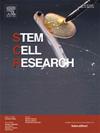四种人类多能干细胞系携带与opa1相关的视神经萎缩变异
IF 0.7
4区 医学
Q4 BIOTECHNOLOGY & APPLIED MICROBIOLOGY
引用次数: 0
摘要
我们从皮肤活检来源的具有OPA1致病变异的成纤维细胞中产生了四个人类iPSC系。供体临床诊断为视神经萎缩。三港杂合推定功能丧失(pLOF)变异,c.1608 + 1_1608 + 6delGTGAGG;c.2873_2876delTTAG;和c.635_636delAA;1例患者为无义等位基因c.676C> p.(Gln226Ter)和错义修饰等位基因c.1146A> p.(Ile382Met)的复合杂合。所有iPSC系使用非整合的仙台病毒技术进行重编程,并在RNA和蛋白质水平上使用未分化的hPSC状态标记进行验证。OPA1 iPSC细胞系分化为视网膜神经节样细胞,为研究基于细胞的药物筛选的发病机制和发展提供了有益的平台。本文章由计算机程序翻译,如有差异,请以英文原文为准。
Generation of four human pluripotent stem cell lines harboring OPA1-related optic atrophy variant
We have generated four human iPSC lines from skin biopsy-derived fibroblast cells with pathogenic variants in OPA1. Donors have a clinical diagnosis of optic atrophy. Three harbor heterozygous presumed loss-of-function (pLOF) variants, c.1608 + 1_1608 + 6delGTGAGG; c.2873_2876delTTAG; and c.635_636delAA; one patient is compound heterozygous for a nonsense allele c.676C>T p. (Gln226Ter) and a missense modifier allele c.1146A>G p.(Ile382Met). All iPSC lines were reprogrammed using non-integrating Sendai virus techniques and validated with undifferentiated hPSC state markers at RNA and protein level. OPA1 iPSC lines differentiate into retinal ganglion-like cells, providing a useful platform to study pathogenesis and development of cell-based drug screens.
求助全文
通过发布文献求助,成功后即可免费获取论文全文。
去求助
来源期刊

Stem cell research
生物-生物工程与应用微生物
CiteScore
2.20
自引率
8.30%
发文量
338
审稿时长
55 days
期刊介绍:
Stem Cell Research is dedicated to publishing high-quality manuscripts focusing on the biology and applications of stem cell research. Submissions to Stem Cell Research, may cover all aspects of stem cells, including embryonic stem cells, tissue-specific stem cells, cancer stem cells, developmental studies, stem cell genomes, and translational research. Stem Cell Research publishes 6 issues a year.
 求助内容:
求助内容: 应助结果提醒方式:
应助结果提醒方式:


